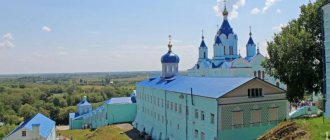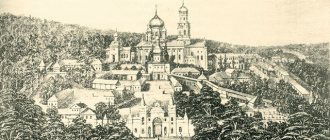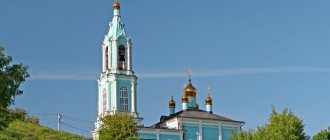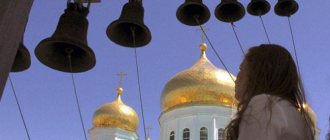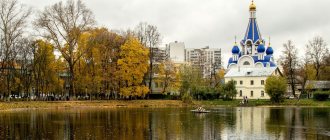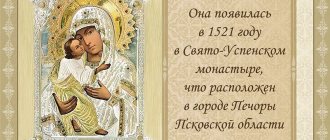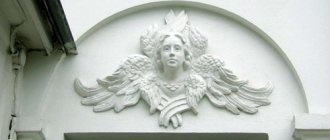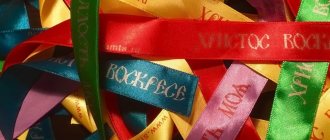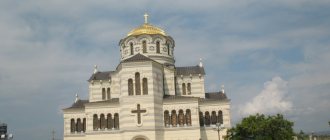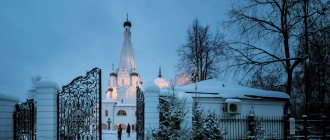Mir
Ukraine Sumy region village of Novaya Sloboda Nativity of the Blessed Virgin Mary Sofronieva Molchanskaya Pechersk men's hermitage Map is loading…
{"format":"leaflet","minzoom":false,"maxzoom":false,"limit":50,"offset":0,"link":"all","sort":[""], "order":[],"headers":"show","mainlabel":"","intro":"","outro":"","searchlabel":"\u2026 \u0441\u043b\u0435\ u0434\u0443\u044e\u0449\u0438\u0435 \u0440\u0435\u0437\u0443\u043b\u044c\u0442\u0430\u0442\u044b","default":"","import-annotation":false,"width ":"auto","height":"350px","centre":{"text":"","title":"""link":"""lat":51.3750849999999985584508976899087429046630859375,"lon": 34.13076199999999715828380431048572063446044921875,"icon":""},"title":"","label":"","icon":"","lines":[],"polygons":[],"circles":[ ],"rectangles":[],"copycoords":false,"static":false,"zoom":8,"defzoom":14,"layers":["OpenStreetMap"],"image layers":[] ,"overlays":[],"resizable":false,"fullscreen":true,"scrollwheelzoom":true,"cluster":false,"clustermaxzoom":9,"clusterzoomonclick":true,"clustermaxradius":80, "clusterspiderfy":true,"geojson":"","clicktarget":"","showtitle":true,"hidenamespace":false,"template":"","userparam":"","activeicon": "","pagelabel":false,"ajaxcoordproperty":"","ajaxquery":"","locations":[{"text":"\u003Cb\u003E\u003Ca href=\"/palomnik/%D0% A0%D0%BE%D0%B6%D0%B4%D0%B5%D1%81%D1%82%D0%B2%D0%B0_%D0%9F%D1%80%D0%B5%D1%81% D0%B2%D1%8F%D1%82%D0%BE%D0%B9_%D0%91%D0%BE%D0%B3%D0%BE%D1%80%D0%BE%D0%B4%D0% B8%D1%86%D1%8B_%D0%A1%D0%BE%D1%84%D1%80%D0%BE%D0%BD%D0%B8%D0%B5%D0%B2%D0%B0_% D0%9C%D0%BE%D0%BB%D1%87%D0%B0%D0%BD%D1%81%D0%BA%D0%B0%D1%8F_%D0%9F%D0%B5%D1% 87%D0%B5%D1%80%D1%81%D0%BA%D0%B0%D1%8F_%D0%BC%D1%83%D0%B6%D1%81%D0%BA%D0%B0% D1%8F_%D0%BF%D1%83%D1%81%D1%82%D1%8B%D0%BD%D1%8C\» title=\»\u0420\u043e\u0436\u0434\u0435\u0441\ u0442\u0432\u0430 \u041f\u0440\u0435\u0441\u0432\u044f\u0442\u043e\u0439 \u0411\u043e\u0433\u043e\u0440\u043e\u0434\u0438\u0 446\u044b\u0421\u043e\u0444\ u0440\u043e\u043d\u0438\u0435\u0432\u0430 \u041c\u043e\u043b\u0447\u0430\u043d\u0441\u043a\u0430\u044f \u041f\u0435\u0447\u0 435\u0440\u0441\u043a\u0430\ u044f \u043c\u0443\u0436\u0441\u043a\u0430\u044f \u043f\u0443\u0441\u0442\u044b\u043d\u044c\»\u003E\u0420\u043e\u0436\u0434\ u0435\u0441\u0442\u0432\ u0430 \u041f\u0440\u0435\u0441\u0432\u044f\u0442\u043e\u0439 \u0411\u043e\u0433\u043e\u0440\u043e\u0434\u0438\u0446\u044b \u 0421\u043e\u0444\u0440\u043e\ u043d\u0438\u0435\u0432\u0430 \u041c\u043e\u043b\u0447\u0430\u043d\u0441\u043a\u0430\u044f \u041f\u0435\u0447\u0435\u0440\u0 441\u043a\u0430\u044f\u043c\ u0443\u0436\u0441\u043a\u0430\u044f \u043f\u0443\u0441\u0442\u044b\u043d\u044c\u003C/a\u003E\u003C/b\u003E","title":"\u0420\u043e \u0436 \u0434\u0435\u0441\u0442\u0432\u0430 \u041f\u0440\u0435\u0441\u0432\u044f\u0442\u043e\u0439 \u0411\u043e\u0433\u043e\u0440\ u043e\u0434\u0438\u0446\u044b \u0421\u043e\u0444\u0440\u043e\u043d\u0438\u0435\u0432\u0430 \u041c\u043e\u043b\u0447\u0430\u043d\u0441\u043a\u0430\u044f u041f\u0435\u0447\u0435\u0440 \u0441\u043a\u0430\u044f \u043c\u0443\u0436\u0441\u043a\u0430\u044f \u043f\u0443\u0441\u0442\u044b\u043d\u044c","link":"","lat":51 .3750849999999985584508976899087429046630859375 ,"lon":34.13076199999999715828380431048572063446044921875,"icon":""}],,"imageLayers":[]}
51.375085; 34.130762
Ukraine, Sumy region, Konotop district, Novoslobodskaya rural community, Novaya Sloboda village
Novaya Sloboda village, Sumy region
Ukraine
Telephone:
(05442) 6–12–17, (097) 864–62–14
Sofronievsky Monastery
(full name of the Sofroniyevo-Molchanskaya Pechersk hermitage of the Nativity of the Blessed Virgin Mary)
of the Nativity of the Blessed Virgin Mary Sofronieva Molchanskaya Pecherskaya hermitage for men
is an Orthodox male monastery of the Konotop and Glukhiv diocese of the Ukrainian Orthodox Church of the Moscow Patriarchate, located on Mount Wonderful in the village of Novaya Sloboda, Sumy region.
It was founded in 1630. It was closed under Soviet rule and returned to the church in 1999. One of the seven wonders of Sumy region.
History[edit]
In the description of 1837 (known from references to it in 1895), the foundation of the monastery is hypothetically attributed to the period between the Baptism of Rus' (988) and the death of St. equal to Prince Vladimir (1015); in the description of 1845 (published in 1846 and 1880), the foundation is attributed to the monks of the Kiev-Pechersk Lavra and is associated with their departure from Kyiv, devastated by the Mongols (1240); the description of 1895 offers a compilative version: the monastery arose before the Mongol invasion, but was sparsely populated, and after 1240 the monks of the Lavra were included among its brethren. In the XVII-XVIII centuries. A number of legends were recorded in the desert, dating its history back to the 14th-15th centuries. In 2002 and 2004 An archaeological expedition from the Glukhovsky State Historical and Cultural Reserve discovered in the desert traces of the monastery’s activity in the pre-Mongol and post-Mongol periods (the main dating material was fragments of ceramics from samples of the 12th-13th and 13th-14th centuries).
One of the written traditions says: “By the will of God, two hermit-monks came to this place from the Kiev borders, and having found ... a small cave, and renovated it, I lived in it, acquiring nothing, except that I had an image of the Most Holy Theotokos, to Her I took out I pray day and night, and eat vegetables and alms from Christ-lovers. And so, having lived a godly life, died, and was laid in a cave.” The description of 1845 states that the legend spoke of the arrival of monks in 1300 to a deserted place (perhaps the date is tied to the synchronous chronicle message: “Unable to endure the Tatar violence... all of Kyiv fled”); a description from 1895 complements this information: already during the time of the Lithuanian Prince Olgerd (1345-1377) the monastery had a rector, Archimandrite Philaret, and received taxes from the nobles of the city of Putivl, then it was ruined “from the presence of barbarians and other various people,” and after some time of desolation 2 Kyiv monks came here.
After the death of the monks, the mountain was empty again - only beekeepers sometimes visited here, collecting honey in the surrounding forests. 18 Sep. 1405 One day a beekeeper who came to the mountain saw a glow emanating from a linden tree. Coming closer, he discovered an icon of the Mother of God standing on a linden tree, bowed and heard a voice: “May the Church of the Most Pure Mother of God be built in this place!” After praying some more, the beekeeper went to Putivl, where he told about everything that had happened. Further, the legend says: “The pious people of the city of Putivl, many gathered with the priests, went with this man to the place where the holy icon appeared, and seeing it, sang a prayer service with tears and joy, and bowed down. And then there were many miracles and healings for the sick. And at that time, in this place, they built a small prayer temple (probably a chapel) and in it, taking it down from the tree, they placed that miraculous icon.” Then the Putivlyans sent a messenger to Moscow to Metropolitan St. Cyprian for a blessing “to build a church in this place in the name of the Nativity of the Blessed Virgin Mary.” The blessing was given, and “so... on this deserted place a communal monastery was built, and the abbot was with the brethren, and a wooden church was erected... And from that time on, from the miracles of the Most Holy Theotokos, this place was glorified.”
Continuation…
See also:
Historical and statistical description of the Molchanskaya Nativity-Virgin Pechersk men's dormitory Sophronievo hermitage and the monastery attached to it in the name of the Prophet, Forerunner and Baptist of the Lord John, located in the Kursk diocese (1895, 179 pages)
Remaining Legacy
The main temple of the monastery, built on the site of the miraculous appearance of the icon, was destroyed in 1960. After the barbaric destruction, this place was plowed up and made a place for grazing livestock. According to the recollections of eyewitnesses, before the temple disappeared, it was also subjected to desecration, which is difficult for a sane person to comprehend. A cowshed was made in the Cathedral of the Nativity of the Virgin Mary, calves were kept in the Annunciation Church, and pigs were kept in other churches and buildings. According to the recollections of old-timers who were young then, they had to milk cows in the temple. People cried, because there were faces of saints around, but they were forced to. Ruins remain of the gateway Church of the Intercession; now it has been restored in the Ukrainian Baroque style. The rector's building with the Elias Church in the neo-Russian style was also reconstructed. Work is underway to restore the Church of Saints Anthony and Theodosius of the Pechersk (refectory).
Description[edit]
The territory of the Sofronievsky Monastery (view from the courtyard) at the beginning of the twentieth century,
the Monastyrsky Cape is completed by 2 wedge-shaped protrusions directed to the southwest and southeast. From the ancient buildings of the monastery, only a few above-ground stone structures have been preserved: the gateway Church of the Intercession, the former refectory building, the former “new” hospital building with the Church of St. prophet Elijah, the arch of the South Gate with part of the fence; the gateway Church of the Intercession is located in the middle of the longitudinal axis of the cape; the former refectory building is on the south-eastern ledge; the former “new” hospital building - in the southwest; The southern gate with part of the fence is at the end of the southwestern protrusion of the cape.
In the triangle between the Intercession Church and the named buildings was the core of the architectural ensemble of the monastery; to the north of the Church of the Intercession, on both sides of the road to Novaya Sloboda, monastery gardens stretched; In addition to the garden, a rectangular Gostiny Dvor with premises for pilgrims was adjacent to the western side of the road; southeast of the refectory building, on the slopes of the promontory of the cape, there was a household (“economic”) courtyard.
A number of underground rooms have also been preserved on the territory of the monastery: the cellars of the destroyed sacristy building, which stood to the northwest of the refectory, and several complexes of caves under the eastern slopes of the cape. The most remarkable of the cave complexes is located under the tip of the southwestern ledge (it is lined with brick on the walls and vaults, has an underground temple; the entrance to the complex is located on the southeastern slope of the cape ledge).
The Church of the Intercession of the Blessed Virgin Mary with the Holy Gates of the monastery on the 1st floor was built in 1757 in the Baroque style (restored in 2003-2004). To the east of the temple, on the same axis, there was a 2-story stone abbot's building (1st half of the 19th century). To the southwest of the Intercession Church there was a stone Church of the Ascension of the Lord (1801-1808); its northern and southern side walls were adjacent to the ends of 2 large stone 1-story rooms: the northern one was occupied by a hospital and a pharmacy, the southern one was occupied by cells and a prosphora room.
The former refectory building was built at the turn of the 17th-18th centuries. The western part of the building is occupied by a chamber, the vaults of which are supported by 2 square pillars; in the semi-basement of the building on the eastern side there is another ward-type room - with a single central pillar. During repairs and reconstruction in the beginning. XXI century a high dome was built over the eastern half of the building. To the north-west of the former refectory, cellars have been preserved in the sacristy building, which has been preserved since its construction in the 2nd half. XVII century and until the beginning XIX century served as the abbot's house.
To the northeast of the sacristy there was a stone church of the Nativity of the Blessed Virgin Mary. Explorers of the 19th century the completion of its construction was attributed to 1734; modern scientists date the primary stone structure to ca. 1630; Later, the temple was rebuilt several times and reached the times of the revolution in the form it found in the beginning. XIX century To the north of the sacristy, almost parallel to the Church of the Nativity of the Blessed Virgin Mary, there was another stone church, 2 floors of which, with the lower Annunciation and upper Assumption chapels, were built in 1710 and 1718. Adjacent to the western end of the building was a bell tower with a height of approx. 50 m (turn of the 18th-19th centuries). South-west of the sacristy, on the upper edge of the depression between the protrusions of the cape, there was a 2-story stone fraternal building (early 19th century).
The former “new” hospital building with the Church of St. prophet Elijah was built in 1911 in the so-called neo-Russian style; the decor of its unplastered facades is made of brickwork. To the south of this building, at the end of the promontory of the cape, there are the 3-arched South Gate of the monastery, from which the surviving parts of the ancient fence stretch in a crescent to the northwest and northeast.
On the eastern slopes of the cape there are several complexes of monastic caves. The most remarkable complex lies beneath the end of the southwestern promontory of the cape, within an area of ca. 55 x 45 m. The entrance to the dungeon is located on the slope southeast of the South Gate. The complex consists of underground corridors, cells and a temple. The walls and vaults of the dungeon are lined with brick dating back to the 18th century. Iron connections are fixed in the vaults of the temple (according to scientists, this indicates an open method of constructing this complex of caves: first they dug a foundation pit, then built cave streets, cells and a temple in it, and finally poured earth on top of the vaults). In descriptions of the 19th century. the cave church is mentioned as “renewed” in 1766 and then consecrated in honor of St. Anthony and Theodosius of Pechersk; according to the same descriptions, in 1805 the temple was renamed in honor of the Nativity of Christ.
The splendor of the monastery
If you look at photographs of the Sofronievsky Monastery in the 19th - early years. XX century, you can see a magnificent architectural ensemble, which in appearance was in no way inferior to the largest monasteries of that time. In total, there were more than 60 buildings on the territory, and among all the buildings it is worth noting the Cathedral of the Nativity of the Virgin Mary (1630). It had an ancient iconostasis of Greek painting, renewed in 1839, icon cases of excellent workmanship and miraculous icons, royal silver gates. It was also possible to highlight the Church of the Annunciation and Assumption (two-story), a high five-tier 70-meter bell tower, the gateway Church of the Intercession (1757), and a cave temple. There were fountains and luxurious flower beds. A hundred years ago, there were about 300 inhabitants in the Sophronium Hermitage and monastery, among them there were 108 monks. For centuries, the most valuable books, including the first printed ones, were carefully collected. Prosperity went hand in hand with mercy. During the First World War, a free canteen operated at the monastery, where pilgrims, refugees and disadvantaged people were given food, and an orphanage was opened for the children of fallen servicemen.
Saints[edit]
14 Apr 2009 Priest. The Synod of the UOC decided to canonize St. Sophrony (Batovrina), hieromonk Serapion, Theodosius (Maslov), novice Sergius Tikhonov. On June 28, 2009, a ceremony of glorifying these ascetics as saints took place in the desert.
* St. Sophrony (Batovrin)
From the surviving texts of letters it is known that in the 2nd half. XVII century The hermits of the Shiryaevsky forest near Putivl - Alexander and Sophrony with their associates - were resettled in the deserts. Hieromonk Alexander, according to legend, appeared in the Shiryaevsky forest “from the borders of Kyiv.” About Fr. Sophronia, historiographers of the 19th century desert. they write that he is a native of Putivl, in the world Stefan Batovrin, “a noble merchant man,” decided to become a monk, left his wife and children, came to Fr. Alexander and received tonsure from him. According to the letters, Khilkov transferred the Shiryaev monks, against their will, to the Molchansk hermitage, but after this the Putivl monastery not only did not provide them with the necessary funds for living, but completely confiscated from them even those donations that visiting pilgrims left for the hermits. The hermits complained to Patriarch Nikon of Moscow, and he, with his letter dated March 25, 1654, made a strict reprimand to the Putivl abbot Joseph. On March 10, 1656, Patriarch Nikon informed the Putivl governor that, at the request of Elder Sophrony and other silent hermits, he would grant their monastery independence; the same document indicates the new abbot of the Putivl monastery - Alexander, probably the former head of the desert. Over time, the Putivl monastery’s claims to the hermitage were renewed, but Fr. Sophrony turned to the tsar, and with a letter dated May 12, 1670, Alexy Mikhailovich confirmed the independence of the hermits. In the document, Elder Sophrony is called the builder of the desert (the letters are silent about the rank of Father Sophrony, and legend says that due to his humility, the elder did not dare to accept the priesthood). Through the works of Fr. Sophronia's monastery achieved prosperity. A phrase from the royal letter dated February 13 is indicative. 1671: it is said here about Elder Sophrony that “they would give him a cart to Moscow to bring various vegetables and garden trees for the royal use.”
On Dec. 1692 about. Sophrony died. In memory of him, the Molchansk Hermitage was also called Sofronieva. Despite the respect that Fr. Sophrony at the royal court, he was once slandered before the patriarch by the abbot of the desert Roman (since, according to legend, the humble builder did not accept the priesthood, the abbot was formally older than him); the ascetic was sent into exile to the Moscow Chudov Monastery, but the brethren achieved his return (for their assistance in this, in April 1672 they thanked the abbot of the Chudov Monastery, Joachim, the future patriarch, in a letter). In 1677 a new exile followed: Fr. Sophrony “took temporary punishment from his great direct simplicity, and not from malice in his words and boldness”; this time Fr. stood up for the elder. Sylvester (Medvedev), a former employee of the tsar's chancellery, temporarily lived in the Sophronium Hermitage and took monastic vows there: he wrote to the Romodanovsky princes asking them to turn to the hetman of Ukraine Ivan Samoilovich with a request to intercede for Fr. Sophronia (in his letter, petitioner Fr.
* St. Serapion
A worthy successor to Fr. Hieromonk Serapion, who died on July 17, 1718 at the age of 81, took over the management of the monastery. Monastic tradition indicates the following miraculous incident: one day Fr. Serapion went to Sumy to buy iron for the Assumption Church he was building, and on the way he was attacked by robbers; finding himself between his pursuers and the Seim River, the builder ordered the confused coachman: “Go, child, don’t you see the bridge in front of you?”; the coachman looked ahead and saw a bridge, which in fact did not exist, and the carriage rushed along the waters of the Seim; Observing this, the robbers brought repentance to Fr. Serapion, and later, despite the builder’s ban on disclosing anything, they told the surrounding residents about the miracle.
* St. Feodosius (Maslov)
From 1779 until his death on December 9. In 1802, the monastery was ruled by Elder Theodosius (Maslov), in the world Theodore. A native of Glukhov, he went to the Bryansk Svensky Monastery as a young man, and from there to the Moldavian Berezunsky monastery of St. Vasily Polyanomerulsky (†1767), whose student, tonsure and successor he became. Later, having become the abbot of the Tisman monastery in Wallachia, Fr. Theodosius provided food assistance to the Russian army fighting the Turks; by this he incurred the wrath of the Turkish authorities, and was forced to seek refuge in the Russian Empire, where he received control of the Sophronian hermitage. In the year of his appointment as abbot of the desert, the elder introduced the rules of the Athonite monasteries into it, which were also used in Moldova. Father Theodosius was a friend of St. Paisius Velichkovsky - a native of Poltava (1720), a famous elder of Moldavian monasteries (†1794): a letter has been preserved in which St. Paisiy talks about. Theodosius about his work in translating the works of the ancient holy fathers into Church Slavonic. In 1787, Elder Theodosius was elevated to the rank of archimandrite. Past merits of Fr. Feodosia, in front of the Russian army, helped the elder defend the rights of the monastery to its lands at a time when the seizure of the lands of monasteries of the Russian Empire for the state fund, which began in 1764, continued around.
* St. Sergius (Tikhonov)
In 1829, novice Sergius Tikhonov, a native of Yelets, came from the Kiev-Pechersk Lavra to the Sophronius Monastery; Having lived in the desert for half a century (†November 30, 1879 at the age of 75), he performed obedience in the kitchen and bakery, was a zealous man of prayer, carried out the feat of foolishness in Christ, and had the gift of clairvoyance and healing.
* Ascetics from among the saints of the Glinsk Hermitage
In the beginning. XIX century In the Sophronium Hermitage lived the future famous ascetics of the neighboring Glinsk Hermitage: Abbot Philaret (†1841) and Elder Schema-Archimandrite Iliodor (†1879).
The future abbot Philaret, in the world Thomas Danilevsky, who first lived in the Kiev Pechersk Lavra, met the monks of the Sophronium Hermitage who came here and was deeply impressed by the guests’ story about their monastery. After this, at night Thomas saw Fr. Theodosius, who called the young man into the desert. In 1802, Thomas arrived there, and Fr. Theodosius said at the meeting: “This brother will give rest to my soul. My soul rejoices in him.” At the same time, Thomas took monastic vows in the desert with the name Philaret, in 1803 he became a hierodeacon, in 1806 - a hieromonk and dean of the monastery. In 1815 Fr. Philaret was offered to be the rector of the desert, but out of humility he refused. At the request of the monks of the Glinsk Hermitage in 1817, Fr. Philaret was appointed their rector, which he remained until his death.
The future Glinsk elder Schema-Archimandrite Iliodor, in the world John of Golovanitsky, was also at first a novice of the Lavra, where he came after the Patriotic War of 1812. Then he lived in the Sophronium Hermitage and from there moved to Glinskaya, where in 1824 he became a monk with the name Ioannikiy, and later the schema with the name Iliodor.
An animated garden
Sofronievskaya Hermitage was famous for its apples; these fruits were even supplied to the royal table along with vegetables, starting from the 17th century. After the destruction of the monastery under the Bolsheviks, the trees did not bear fruit; nature decreed this in retaliation for the insult to the shrine. Since the beginning of the 50s, the apple orchards did not give birth at all, everything froze, and after the opening of the monastery and the appearance of the first monks in our time, everything bloomed here. All eight gardens in the monastery began to smell fragrant. There were frosts at that time, and everything around was frozen, but not in the monastery - in September there were huge and tasty apples hanging on the branches. And such miracles happen in our time.
Shrines[edit]
Molchenskaya Icon of the Mother of God
Among the shrines of the monastery is a list of the Molchenskaya Icon of the Mother of God
.
Descriptions of the 19th century They say that during the devastation of the desert in 1605, the monks transferred the revered image of the Most Holy Theotokos to the Putivl Molchensky Monastery. Authors write differently about the further fate of the shrine. The description of 1845 reports that the icon subsequently died in a fire at the Putivl Monastery, and in the desert after new monks arrived there, only a copy of the image was kept. The description of 1895 claims that after its revival, the icon that appeared in 1405 was returned to the desert, and the monastery in Putivl had its own miraculous image of the Mother of God, revealed “as it is said about this in the Moscow inventory registers,” April 24. 1635 near Molchi, in the Linevsky forest, at the “Kobozeva Krinitsa” well, and it is this image that the author of the description calls lost in the fire of the Putivl Monastery in 1752. Whatever version is correct, none of those revealed in 1405 and 1635. The Molchensk icons have not reached us. The list of the Molchensk Icon, now kept in the desert, was written in later times.
Polish military, children of Spain and Russia
The fate of the last monks was tragic: some were expelled, others were exiled, some were killed. In the 30s, there was a concentration camp for prisoners of war; 1,500 Polish officers, officials and members of the intelligentsia were kept within the walls of the monastery. The remote monastery was chosen by representatives of the NKVD, where prisoners were later shot. There are moments in history when one evil gives rise to another and can be returned to descendants in some form. The Molchensk Hermitage was often plundered and destroyed, and in 1605 the monastery was destroyed by the Poles.
At one time there was also an orphanage in the monastery, to which children were brought from the starving Volga region. During the war in Spain, children were brought here from this southern country. During World War II, the monastery buildings were used for their needs by Soviet partisans under the leadership of Sidor Kovpak.
Patronal holidays[edit]
Nativity of the Blessed Virgin Mary
- September 21
Protection of the Blessed Virgin Mary
- October 14
Celebration in honor of the Molchensk Icon of the Mother of God April 24 (May 7), September 18 (October 1)
Elijah the Tishbite, prophet
- August 2
Cathedral memory of the ascetics who labored in the Sophronius Hermitage on May 12 (25)
Myrrh-streaming icon
Once during Holy Week, the Iveron Icon of the Mother of God began to exude myrrh here. This image has been revered in the monastery for a long time; at that moment it was on the temple throne. And before that, there was a wonderful discovery of an ancient icon that local residents saw in an antique store. The governor met with the owner of the shop, who said that from the moment he received the icon in his hands, he was in anxiety and his health was constantly deteriorating. The governor of the Sophronium Hermitage offered to return the shrine to the monastery, and after this the store owner was healed.
Location[edit]
South of the village of Novaya Sloboda there is a hill with numerous ledges along the edges. On one of these ledges, stretching in the form of a cape from north to south, having gentle slopes and called Wonderful Mountain, the monastery is located. The Molche swamp has long stretched southeast of Wonderful Mountain, from which part of the name of the monastery came (in the “Historical and Statistical Description” of the monastery in 1895).
Address:
41500, Ukraine, Sumy region, Putivl district, village. Novaya Sloboda
Telephone:
(05442) 6–12–17, (097) 864–62–14
Temple without domes and swallows at the Liturgy
Twenty years ago, the Divine Liturgy was celebrated here for the first time after 77 years of mockery and desolation. A grandfather lives in the village, who, back in Soviet times, walked around the monastery and said to a boy, later a resident of the monastery: “Vanyushka, the Mother of God is preparing monks. There is already a governor and brethren, and they will begin to rebuild the building from this building.” The guy didn’t believe it and pointed to the ruins. And Ivan Filippovich (that’s his name) continued: “The Queen of Heaven will arrange everything, and you will stand in the service more than once.” And when the first Liturgy was going on in a church without domes, the wind was whistling all around, 80-year-old Ivan Filippovich came to the church and began to cry. During the first Liturgy, swallows arrived and flew in a circle, chirping along with the singing choir. They sang together with Cherubimskaya, but there was dead silence at the Eucharistic canon. After the Lord's Prayer, the birds began to chirp and fly around the temple again. Such a sign gave hope to the first inhabitants that the Mother of God showed her favor through feathered creatures.
Prophecy of St. John of Kronstadt
Once upon a time St. served in this monastery. John of Kronstadt. One day he went out onto the balcony of the Annunciation Church, bowed low and said the following words: “The time will come, the monastery will be desolate, but then it will be reborn and become better than before.” The monks believe this, the brethren put in a lot of effort and work, pray - and the results are visible. In the Sofronievsky Monastery they believe that the Mother of God is their abbess. Pilgrims who come here also believe in this; the presence of God’s grace is felt here, and not only because there is magnificent nature around the monastery, but here one can feel a place of prayer where saints lived and worked and where the sweat and blood of Christians was shed.
Andrey German
How to get there[edit]
Directions:
Sofronieva Pustyn is located in the Arzamas district of the Nizhny Novgorod diocese, in the forest, between the villages of Kovaksa, Nikolskoye and Naumovka (seven kilometers from Kovaksa). You can get to Arzamas from other cities by bus or train in Nizhny Novgorod, Kazan, Samara directions (if you come from Moscow, St. Petersburg). From any of the two stations in the city, take bus No. 1 to Cathedral Square, from there on foot to the bus station, where buses to Piyavochnoe run at intervals of 2–5 hours (May 2007 schedule: 5:05, 7:15, 12:40, 17 :55). Drive to the village of Kovaksa, get off at the second stop. There, ask Severnaya Street, where the Pustyn courtyard is located in house No. 54. From there it is a 10 km walk to the Desert into the forest. There are opportunities on a horse or tractor, which you can find out about in advance by calling. In any case, if possible, please call the courtyard in advance to notify of your arrival and receive a blessing.
Address:
607217, Nizhny Novgorod region, Arzamas district, village. Kovaksa, st. Severnaya d. 54
Tel.:
8 (3147) 56-111
Email:
Official site
